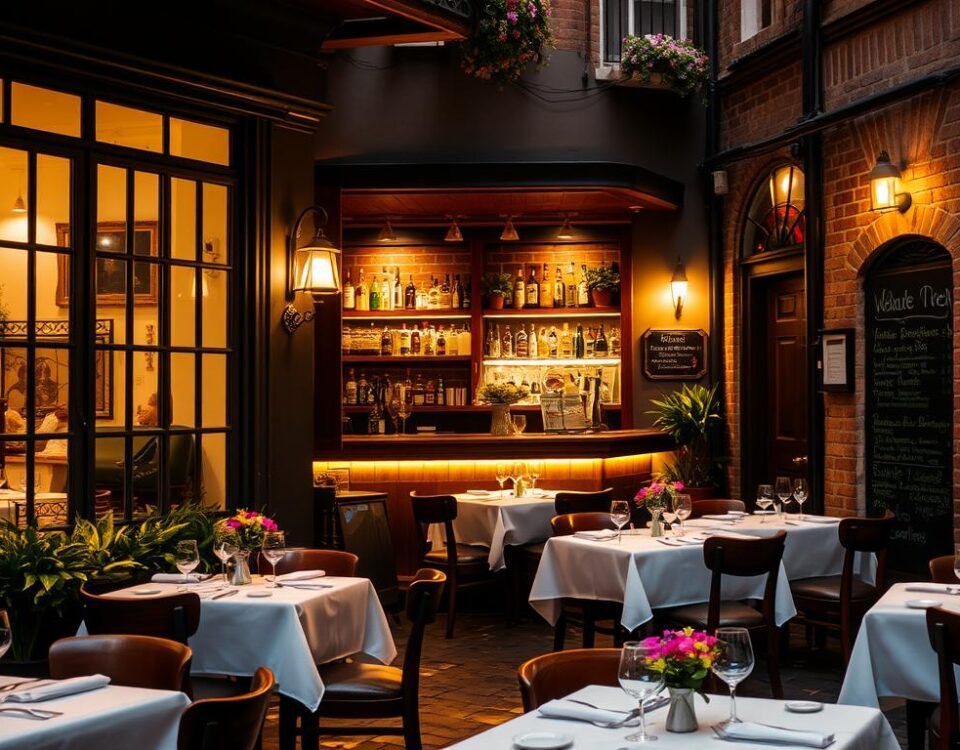
Why Your Restaurant Might Fail Before Opening — And How to Prevent It
July 12, 2025
Opening a Restaurant? Don’t Miss These 10 Crucial Steps
July 13, 2025As I reflect on my journey as a restaurant owner, I realize that opening a restaurant is a dream shared by many, but it’s a venture fraught with challenges that can quickly turn that dream into a nightmare.
Did you know that a staggering number of new restaurants fail within their first year of operation? This harsh reality underscores the importance of being aware of the pitfalls that can sink your business before it even gets off the ground.
As a first-time restaurant owner, you’ll face numerous challenges that can feel overwhelming if you’re not prepared. The key to success lies in understanding the common mistakes that can doom your business and learning how to avoid them.
Key Takeaways
- Understand the most common pitfalls that first-time restaurant owners face.
- Learn how to avoid fatal mistakes that can sink your restaurant.
- Discover actionable strategies to position your restaurant for long-term success.
- Gain insights into the challenges of opening a restaurant and how to overcome them.
- Develop a comprehensive plan to navigate the competitive restaurant industry.
The Reality of Restaurant Ownership
Running a restaurant is a complex endeavor that requires more than just a passion for food. The restaurant industry is a high-risk business proposition, with heavy competition and a myriad of details to perfect. Ensuring success, especially in restaurant startups, seems like a significant gamble.
New restaurant managers and owners are often very eager to please their customers and solidify their reputations as providing the highest quality food and best service. However, the reality is that the restaurant business is notoriously challenging, with statistics showing that nearly 30% of restaurants fail within their first year of operation.
Why So Many New Restaurants Fail
Many people enter the restaurant industry with rose-colored glasses, focusing on their passion for food without understanding the business realities. The market is saturated with restaurants competing for the same customers, making it essential to differentiate your concept. First-time restaurant owners often underestimate the sheer amount of work involved in running a successful establishment.
What It Takes to Succeed in the Food Industry
Success in the food industry requires more than just culinary talent—it demands business acumen, operational efficiency, and strategic planning. Building a strong staff foundation from the beginning is essential for delivering consistent quality and service. Understanding why so many restaurants fail can help you avoid the same fate by learning from others’ mistakes.
The restaurant industry demands resilience, adaptability, and a willingness to learn from both successes and failures. A lot of restaurant failures could be prevented with proper planning and realistic expectations about what it takes to succeed.
Fatal Mistake #1: Skipping the Business Plan
One of the most critical mistakes first-time restaurant owners make is skipping the business plan. A comprehensive business plan serves as the roadmap for your restaurant’s success, outlining everything from your concept and target market to financial projections and operational strategies.
Having a business plan is essential for any new venture, not just restaurants. It helps set future objectives and devise strategies to achieve them, ultimately saving time, money, and stress.
Why a Restaurant Business Plan Is Essential
A restaurant business plan is crucial because it helps you secure funding from investors or lenders. It demonstrates that you’ve thought through all aspects of your restaurant business, making it a vital tool for success.
Key Components Every Restaurant Business Plan Needs
Your business plan should include detailed sections on your restaurant concept, market analysis, competitive landscape, marketing strategy, organizational structure, and financial projections. Make sure it addresses key questions about your restaurant’s location, startup costs, and unique selling proposition.
How to Create a Winning Restaurant Business Plan
Creating a winning business plan involves outlining projected revenue, expenses, profit margins, and break-even analysis. Consider seeking professional help from restaurant consultants or business advisors to provide valuable insights for your specific concept.
| Business Plan Component | Description | Importance |
|---|---|---|
| Restaurant Concept | Defines your restaurant’s theme, cuisine, and target audience. | High |
| Market Analysis | Analyzes your target market, including demographics and preferences. | High |
| Financial Projections | Includes projected revenue, expenses, and profit margins. | High |
| Marketing Strategy | Outlines how you plan to attract and retain customers. | Medium |
Fatal Mistake #2: Underestimating Financial Requirements
One of the most significant errors first-time restaurant owners make is underestimating the financial demands of launching a new eatery. Assuming that you will make a profit immediately upon the grand opening of your restaurant is an illusion, and it’s a mistake that will only be met with disappointment.
The cold reality dictates that it takes at least two to three months to build up sales volumes. Initial startup and operating expenses can be budgeted for, but don’t be naive to think that something won’t come up that’s unexpected. Ensuring your start-up budget includes spare room for unexpected or higher costs than originally planned is crucial.
The True Startup Costs of Opening a Restaurant
The true startup costs of opening a restaurant go far beyond just rent and equipment—they include permits, licenses, insurance, initial inventory, staff training, marketing, and a substantial operating reserve.
| Cost Category | Estimated Cost | Actual Cost |
|---|---|---|
| Rent and Utilities | $10,000 | $12,000 |
| Equipment and Furniture | $50,000 | $60,000 |
| Licenses and Permits | $5,000 | $7,000 |
Expecting Immediate Profits
Expecting immediate profits is a dangerous misconception—most successful restaurant take at least 6-12 months to become profitable, with many taking longer.
Creating a Realistic Financial Buffer
Creating a realistic financial buffer is essential—experts recommend having at least 6-12 months of operating expenses in reserve to weather the initial startup period.
By understanding the true financial requirements of opening a restaurant and creating a comprehensive business plan, you can avoid this common pitfall and set your business up for success.
Fatal Mistake #3: Neglecting Location and Market Research
The success of a restaurant hinges on several factors, but perhaps none as crucial as the location and understanding the target market. A well-chosen location can significantly enhance a restaurant’s visibility and accessibility, drawing in customers and driving business. Conversely, a poorly chosen location can lead to a steady decline in customer traffic, ultimately affecting the bottom line.
Why Location Can Make or Break Your Restaurant
A restaurant’s location is vital for attracting customers. It’s essential to choose a location that is highly visible and accessible to your target market. Factors such as parking availability, neighborhood demographics, and foot traffic play crucial roles in determining the success of your restaurant. Many first-time owners prioritize rent costs over strategic value, which can limit customer traffic and visibility.
Understanding Your Target Market
Understanding your target market is essential for tailoring your restaurant’s offerings to meet customer demands. This involves knowing who your potential customers are, what they want, when they dine out, and how much they’re willing to spend. Conducting thorough market research helps in identifying gaps in the industry that your restaurant concept can fill.
Analyzing Competition in Your Area
Analyzing the competition in your area is crucial for identifying market gaps and avoiding oversaturated segments of the industry. By understanding what existing restaurants offer, you can tailor your concept and service to stand out. It’s also important to consider the customer experience from the moment they approach your space, ensuring it’s inviting and accessible.
| Location Factor | Importance | Impact on Restaurant |
|---|---|---|
| Visibility | High | Attracts more customers |
| Accessibility | High | Eases customer entry |
| Parking Availability | Medium | Affects customer convenience |
By making sure to spend time understanding your location and market, you can avoid common pitfalls and set your restaurant up for success.
Fatal Mistake #4: Creating an Unfocused Menu
One of the most critical errors first-time restaurant owners make is creating a menu that lacks focus. A well-crafted menu is essential for guiding customers through your offerings and creating a cohesive dining experience. When a menu is too broad or complicated, it can confuse customers and strain kitchen operations.
A complicated menu not only confuses customers but also leads to higher food costs, increased waste, and quality control issues. Many new restaurant owners try to please everyone by offering an extensive menu, rather than focusing on a few items that they can execute exceptionally well.
The Dangers of a Complicated Menu
A menu with too many options can overwhelm customers, leading to decision paralysis. This can result in a poor dining experience, negatively impacting customer satisfaction and loyalty. Moreover, a complicated menu can slow down service, as kitchen staff struggle to keep up with the diverse offerings.
Balancing Personal Vision with Market Demand
Your menu should reflect your restaurant’s concept and identity while also meeting market demand. Finding this balance is crucial for success. Restaurant owners often include personal favorites on their menu, rather than dishes that align with customer preferences and profit margins.
Menu Design Errors That Drive Customers Away
Poor menu design can frustrate customers and drive them away. Common errors include poor organization, unclear pricing, lack of descriptions, and hard-to-read fonts. A well-designed menu serves as your most important sales tool, guiding customers toward high-margin items and creating a cohesive dining experience.
| Menu Design Element | Best Practice | Common Mistake |
|---|---|---|
| Organization | Clear categories and sections | Cluttered and confusing layout |
| Pricing | Clear and concise pricing | Unclear or missing prices |
| Descriptions | Detailed and appetizing descriptions | Lack of descriptions or too brief |
To avoid these mistakes, consider working with an experienced chef or menu consultant to create a focused menu that balances creativity with practicality. Remember, your menu is not set in stone; be prepared to make adjustments based on customer feedback and sales data to continuously improve your offerings.
Fatal Mistake #5: Mismanaging Staff and Operations
One of the most significant mistakes new restaurant owners make is underestimating the importance of proper staff management and operational efficiency. Effective management of staff and operations is crucial for delivering consistent quality and service, which are vital for customer satisfaction and retention.

Poor Training and Lack of Standard Procedures
Many restaurant owners underinvest in staff training and standard operating procedures, leading to confused employees, inconsistent quality, and frustrated customers. Comprehensive training programs and detailed standard operating procedures are essential for maintaining consistency across all aspects of the restaurant business.
Misunderstanding Your Role as a Leader
New restaurant owners often misunderstand their role as leaders, getting too involved in day-to-day tasks rather than focusing on strategic management and business growth. As an owner, your priority should be to ensure that your restaurant runs smoothly, focusing on customer satisfaction and revenue generation.
Creating Systems That Scale
To achieve long-term success, it’s crucial to create systems that can scale. This means designing operations that function smoothly whether you’re serving 50 or 500 customers a day. Make sure your management approach balances accountability with empowerment, giving staff the tools and authority they need to solve problems independently.
| Aspect | Importance | Action |
|---|---|---|
| Staff Training | High | Implement comprehensive training programs |
| Standard Procedures | High | Develop detailed standard operating procedures |
| Leadership Role | Critical | Focus on strategic management and business growth |
Fatal Mistake #6: Overlooking Permits and Timing
One of the most critical errors first-time restaurant owners make is overlooking the complexities of permits and timing. Many new restaurant owners are eager to open their doors, but they often underestimate the time and effort required to navigate the permitting process. This oversight can lead to significant delays, increased expenses, and a delayed opening.
The Delays That Can Happen
The restaurant opening process is often fraught with unexpected delays, particularly when it comes to obtaining the necessary permits and licenses. For instance, restaurants that start leasing their space with plans to open within a couple of months may find themselves still waiting for approvals by the following year. Remodels and other tasks can take time to get approvals from the city and county, which can be a longer confirmation time than initially planned.
Navigating the Regulatory Landscape
To avoid these delays, it’s essential to research the permitting process thoroughly and identify potential speed bumps that might set you back. This includes understanding local regulations, zoning requirements, health department standards, and building codes. Many first-time restaurant owners drastically underestimate the time required to navigate this complex web of permits, licenses, and inspections needed to open a restaurant legally.
Timing is Everything
Strategic timing for your grand opening is also crucial. Consider the ebbs and flows of the local population and plan accordingly. For example, opening a restaurant in a ski town during the off-season may not be the best strategy. By understanding the local market conditions and timing your opening strategically, you can maximize your chances of a successful launch.
By being aware of these potential pitfalls and taking steps to mitigate them, you can avoid costly delays and ensure a successful restaurant opening.
How to Avoid These Common Restaurant Opening Mistakes
The key to a successful restaurant launch lies in thorough preparation and a deep understanding of the industry. By being aware of the common pitfalls, you can develop strategies to mitigate risks and ensure a smooth opening.
Finding Mentors and Resources
Finding mentors and resources in the restaurant industry can provide invaluable insights that help you navigate challenges more effectively. Connect with successful restaurant owners who can share their experiences and valuable tips for avoiding the pitfalls they encountered. Industry associations, small business development centers, and restaurant-specific forums can provide resources tailored to your needs.
Creating Contingency Plans
Creating contingency plans is essential—your business plan should include strategies for handling various scenarios, from construction delays to staff shortages. Make sure to build financial buffers into your plans, as unexpected expenses are virtually guaranteed when opening a restaurant. Develop relationships with multiple suppliers, service providers, and potential employees before opening to ensure you have backup options.
- Avoiding common restaurant opening mistakes requires a combination of thorough research, expert guidance, and strategic planning.
- Consider a soft opening approach that allows you to test your concept, train staff, and refine operations before a full public launch.
- Seek feedback from friends, family, and industry people during your soft opening phase to identify and address issues before they impact paying customers.
https://www.youtube.com/watch?v=ffVyRNhF6cE
Remember that flexibility and adaptability are key success factors—even the best-laid plans will require adjustments as you navigate the realities of restaurant ownership.
The Importance of Marketing Your New Restaurant
In today’s digital age, marketing your restaurant is not just an afterthought; it’s a fundamental aspect of your business strategy. Effective marketing is crucial for attracting customers, creating buzz around your brand, and ultimately driving sales.
To establish a strong market presence, you need to focus on building your restaurant’s online presence. This involves creating a professional website that showcases your menu items, location, hours of operation, and the unique experience you offer. Your website is often the first point of contact for potential customers, so it needs to make a great impression.
Building Your Restaurant’s Online Presence
A robust online presence extends beyond your website to social media platforms. These platforms provide powerful tools for connecting with potential customers and building anticipation before and after your opening restaurant. High-quality food photography is worth the investment, as compelling images of your signature dishes can drive significant interest online.
Local Marketing Strategies That Work
Local marketing strategies can significantly impact your restaurant’s success. Consider community partnerships, neighborhood events, and targeted promotions to nearby businesses. Offering friends and family previews can generate word-of-mouth marketing and provide valuable feedback before your official opening. Additionally, location-based digital marketing can help you target potential customers who live or work near your restaurant.
| Marketing Strategy | Description | Benefits |
|---|---|---|
| Social Media | Utilize platforms like Instagram and Facebook to showcase your restaurant. | Increased visibility, customer engagement. |
| Local Events | Participate in or host local events to attract new customers. | Community involvement, brand awareness. |
| Influencer Marketing | Partner with local influencers to promote your restaurant. | Reach new audiences, credibility. |
Remember, marketing is an ongoing process, not a one-time effort. It’s essential to allocate resources to marketing throughout your restaurant’s lifecycle to maintain a strong presence and attract repeat customers. By doing so, you’ll be able to create a loyal customer base and drive long-term success for your restaurant.
Managing Your Restaurant’s Finances for Long-Term Success
Long-term success in the restaurant industry hinges on effective financial planning and management. As a restaurant owner, you must be vigilant about your finances to navigate the challenges of a competitive market.

Managing your restaurant’s finances effectively is crucial for long-term success in an industry known for thin profit margins. Your business plan should include detailed financial projections and monitoring systems to track performance against goals.
Inventory Management Best Practices
Effective inventory management is vital to controlling food costs. Best practices include regular stock counts, first-in-first-out rotation, strategic ordering, and waste tracking. Implementing inventory management software can dramatically improve accuracy and efficiency while reducing waste and theft.
Controlling Labor Costs Without Sacrificing Quality
Controlling labor costs without sacrificing quality requires strategic scheduling, cross-training staff, and optimizing your service model. Many successful restaurants maintain food costs between 28-32% of food sales and labor costs between 25-35% of total revenue. Regular financial review sessions help you identify trends, address issues promptly, and make data-driven decisions about your operations.
By focusing on these key areas, you can ensure your restaurant remains financially healthy and poised for long-term success.
Creating a Positive Restaurant Culture
A positive restaurant culture is the backbone of a successful dining experience, influencing both staff and customers. It’s not just about serving food; it’s about creating an environment where employees feel valued and customers feel at home.
Investing in Employees
Treating employees as investments rather than expenses is crucial. This means providing proper training, growth opportunities, and fair compensation. High staff turnover is costly in terms of training time, service quality, and team morale. Investing in employee satisfaction pays dividends by improving service quality and reducing turnover.
Make sure your management approach balances clear expectations with respect and appreciation for your employees’ contributions. Regular team meetings and open communication channels help address issues before they become problems, fostering a collaborative environment.
Fostering Customer Loyalty
Building customer loyalty from day one requires consistent quality, personalized service, and genuine hospitality that makes guests feel valued. Creating memorable experiences for customers increases the likelihood they’ll return and recommend your restaurant to friends and family.
Your restaurant’s culture should be intentionally designed and consistently reinforced through training, recognition, and your own behavior as a leader. Remember, your restaurant’s culture is a reflection of your values and will significantly impact both the employee and customer experience.
Learning From Successful Restaurant Owners
Successful restaurant owners have a wealth of knowledge to share, and learning from their experiences can be invaluable for new entrepreneurs. By studying their strategies and mistakes, you can gain insights into what it takes to succeed in the competitive restaurant industry.
Case Studies: Turning Mistakes Into Opportunities
Many successful restaurant owners have made mistakes but turned them into opportunities for growth. For instance, a restaurant that initially struggled with menu offerings might have adjusted their concept based on customer feedback, ultimately finding a winning formula. These case studies demonstrate the importance of flexibility and resilience in the face of challenges.

Adapting to Industry Changes
The restaurant industry is constantly evolving, with changes in food trends, customers’ preferences, and technological innovations. Successful owners stay ahead by being adaptable and open to new ideas, whether it’s introducing new dishes or implementing efficient service systems. By embracing change, restaurant owners can maintain their competitive edge and continue to attract loyal customers and dedicated employees.
Conclusion
Having examined the critical errors that can derail a restaurant’s success, it’s clear that a well-thought-out strategy is essential for navigating the challenges of the food industry. To achieve success, it’s crucial to avoid the six fatal mistakes we’ve discussed, from skipping a thorough business plan to mismanaging staff and operations. Proper planning and management of finances, including startup costs and ongoing expenses, will provide the necessary runway to achieve profitability. Investing time in finding the right location and developing a focused menu also pays dividends. By following these tips and remaining adaptable, you can create a thriving restaurant business that stands the test of time.
By being mindful of common mistakes and focusing on effective inventory management, you can protect your profit margins and ensure long-term viability. I hope these insights help you on your journey to restaurant ownership success!
FAQ
What are the most common business plan mistakes made by first-time restaurant owners?
Many new restaurant owners fail to create a comprehensive business plan, neglecting to outline key components such as target market, financial projections, and marketing strategies. I recommend including a detailed market analysis and financial plan to ensure success.
How can I avoid underestimating financial requirements when starting a restaurant?
To avoid financial pitfalls, it’s essential to create a realistic budget and financial buffer. I suggest accounting for startup costs, such as equipment, rent, and staffing expenses, and setting aside funds for unexpected expenses.
What role does location play in a restaurant’s success?
A restaurant’s location can make or break its success. I recommend conducting thorough market research to understand your target audience and analyzing the competition in your area to ensure you’re making an informed decision.
How can I create a menu that appeals to customers?
To create a successful menu, it’s crucial to strike a balance between your personal vision and market demand. I suggest avoiding complicated menus and focusing on a few high-quality dishes that showcase your culinary expertise.
What are some common staffing and operations mistakes made by restaurant owners?
Many restaurant owners struggle with staffing and operations due to poor training, lack of standard procedures, and ineffective leadership. I recommend investing in employee training and creating systems that scale to ensure long-term success.
How can I navigate licensing and regulatory requirements when starting a restaurant?
Navigating licensing and regulatory requirements can be daunting, but it’s essential to ensure compliance. I suggest researching local regulations and obtaining necessary permits to avoid delays in your grand opening.
What marketing strategies are most effective for new restaurants?
To attract customers, I recommend building a strong online presence and implementing local marketing strategies, such as social media campaigns and community outreach programs.
How can I manage my restaurant’s finances for long-term success?
Effective financial management is critical to a restaurant’s success. I suggest implementing inventory management best practices and controlling labor costs without sacrificing quality to ensure long-term profitability.



